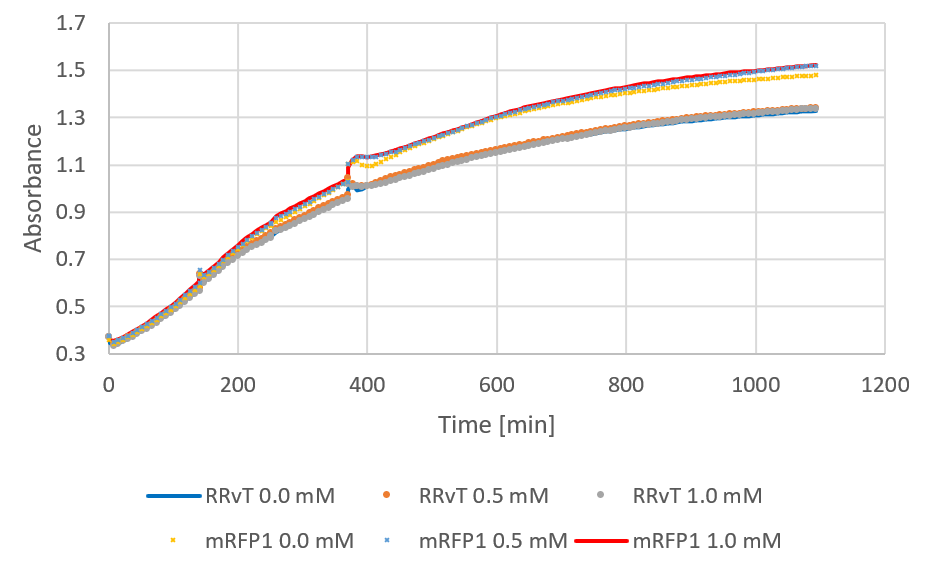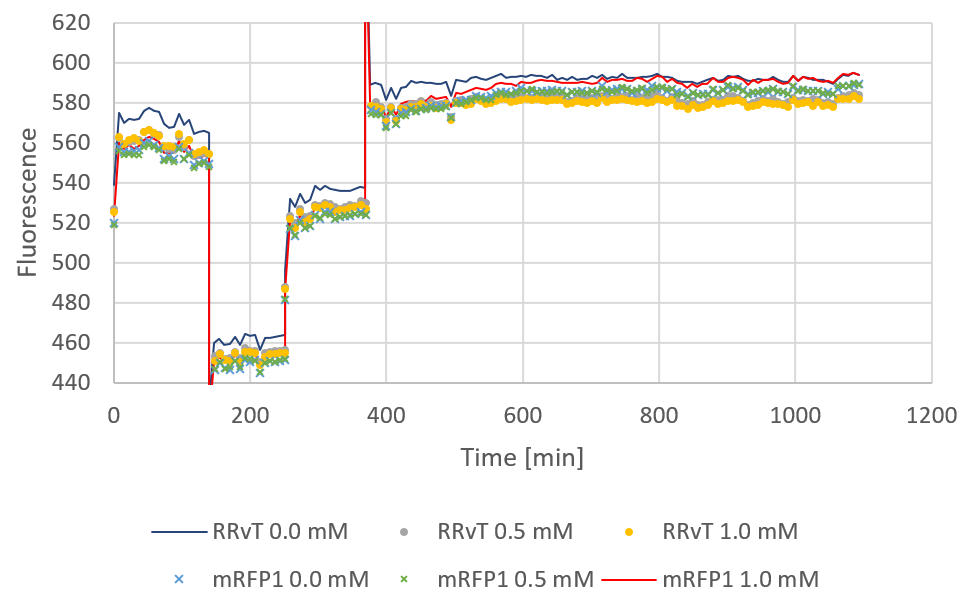| Line 40: | Line 40: | ||
<h2><span class="parts-color">Gold medal criterion #2, and best composite part award </span></h2> | <h2><span class="parts-color">Gold medal criterion #2, and best composite part award </span></h2> | ||
<p style="font-size=120%;"> | <p style="font-size=120%;"> | ||
| + | How many cells does actually attach in the biofilm? | ||
| + | |||
| + | Not all bacteria will attach in a biofilm, and we thought it would be interesting to get an indication about the ratio between cells attached in biofilm and that for planktonic bacteria. As an indicator, a fluorescence protein called RRvT was used and characterized to show the growth of DH5a in LB medium. This was compared to the absorbance-values of DH5a cells attached in biofilm, analyzed by a Crystal Violet assay. For the DH5a cells attached in biofilm they had even grown on 0.4% glucose, but the absorbance values for the planktonic bacteria is still significantly higher than for the attached bacteria. We had also discovered from articles that RRvT works better than RFP in acidic conditions. RRvT actually has a pkA of 3.9. The thought was that if the bacteria needed to grow in acidic conditions in a biofilm, RRvT could still be used to compare the growth in biofilm with the growth of planktonic bacteria. RRvT works as expected because the absorption increases with the growth of the bacteria, but we also discovered some limitations to this method over time. The wells gets saturated with RRvT at a point where the absorption values will not change significantly. | ||
| + | . | ||
To improve a previous part, we decided to change the sequence of the red fluorescent protein coding device BBa_J04450. This was done by replacing the RFP sequence with the sequence for the RRvT. RRvT is a red fluorescent protein with a much higher brightness, and it can be used when the concentration of the inducer is to low to activate the BBa_J04450 biobrick. The RRvT has a very low acid sensitivity which can be useful in many situations. The advantages of RRvT’s strong brightness and it’s low sensitivity of acidic environment makes this protein better than the existing red fluorescent protein <span id="dots">...</span> | To improve a previous part, we decided to change the sequence of the red fluorescent protein coding device BBa_J04450. This was done by replacing the RFP sequence with the sequence for the RRvT. RRvT is a red fluorescent protein with a much higher brightness, and it can be used when the concentration of the inducer is to low to activate the BBa_J04450 biobrick. The RRvT has a very low acid sensitivity which can be useful in many situations. The advantages of RRvT’s strong brightness and it’s low sensitivity of acidic environment makes this protein better than the existing red fluorescent protein <span id="dots">...</span> | ||
<br> | <br> | ||
Revision as of 03:48, 18 October 2018

The RRvT’s low sensitivity of acidic environment makes the new biobrick an improvemt of the existing red fluorescent protein.
Gold medal criterion #2, and best composite part award
How many cells does actually attach in the biofilm?
Not all bacteria will attach in a biofilm, and we thought it would be interesting to get an indication about the ratio between cells attached in biofilm and that for planktonic bacteria. As an indicator, a fluorescence protein called RRvT was used and characterized to show the growth of DH5a in LB medium. This was compared to the absorbance-values of DH5a cells attached in biofilm, analyzed by a Crystal Violet assay. For the DH5a cells attached in biofilm they had even grown on 0.4% glucose, but the absorbance values for the planktonic bacteria is still significantly higher than for the attached bacteria. We had also discovered from articles that RRvT works better than RFP in acidic conditions. RRvT actually has a pkA of 3.9. The thought was that if the bacteria needed to grow in acidic conditions in a biofilm, RRvT could still be used to compare the growth in biofilm with the growth of planktonic bacteria. RRvT works as expected because the absorption increases with the growth of the bacteria, but we also discovered some limitations to this method over time. The wells gets saturated with RRvT at a point where the absorption values will not change significantly.
.
To improve a previous part, we decided to change the sequence of the red fluorescent protein coding device BBa_J04450. This was done by replacing the RFP sequence with the sequence for the RRvT. RRvT is a red fluorescent protein with a much higher brightness, and it can be used when the concentration of the inducer is to low to activate the BBa_J04450 biobrick. The RRvT has a very low acid sensitivity which can be useful in many situations. The advantages of RRvT’s strong brightness and it’s low sensitivity of acidic environment makes this protein better than the existing red fluorescent protein ...
The improved biobrick was synthesized by IDT as a linear sequence containing prefix and suffix. The prefix and suffix sequences can be found at parts.igem.org, and contain restriction enzyme cut sites that can be used to transfer and assemble parts. We then ligated it with the pSB1C3 (sjekk) backbone to make it RFC10 compatible. The improved biobrick contains a lactose induced promoter (Plac BBa_R0010), a ribosome binding site (BBa_B0034), the RRvT sequence and a terminator (BBa_B0015). The new biobrick is therefore a composite part. We have not sent the basic part with the RRvT sequence alone into the registry. Only the composite part was tested and sent in to the iGEM registry.
The testing of the new improved biobrick was done in parallel to the existing BBa_J4450 biobrick. The first time we tested the biobrick we incubated the cell culture, with an OD of approximately 0.1, in a transparent 96 well plate. The parts were measured ca every five minutes for 30 hrs by a Tecan plate reader. When the absorbance reached 0.8
Isopropyl β-D-1-thiogalactopyranoside (IPTG) was added to see if this gave any effect on the fluorescence.
A growth curve for absorbance and fluorescence were then made. These curves were used to determine how the fluorescence changed with time.
The following figure shows growth curves for RRvT and mRFP as absorbance against time.

Fluorescence plotted against time for the two biobricks are shown in the figure below:

As seen from the figures above, the new RRvT biobrick showed no significant improvement of fluorescence. We then decided to do the test using a black 96 well plate.


